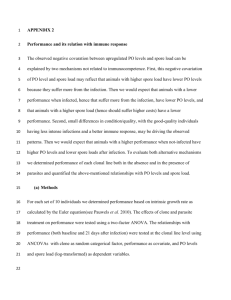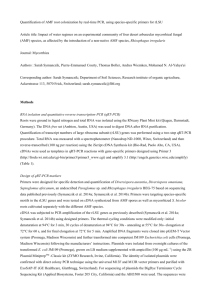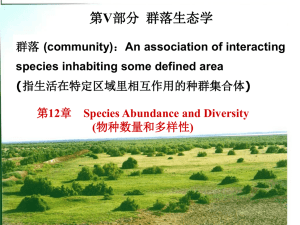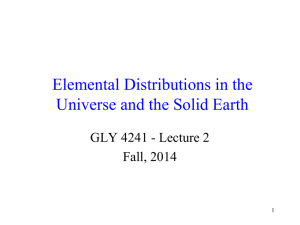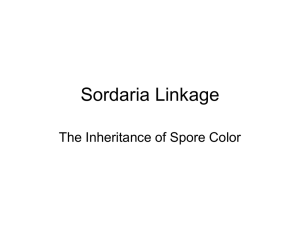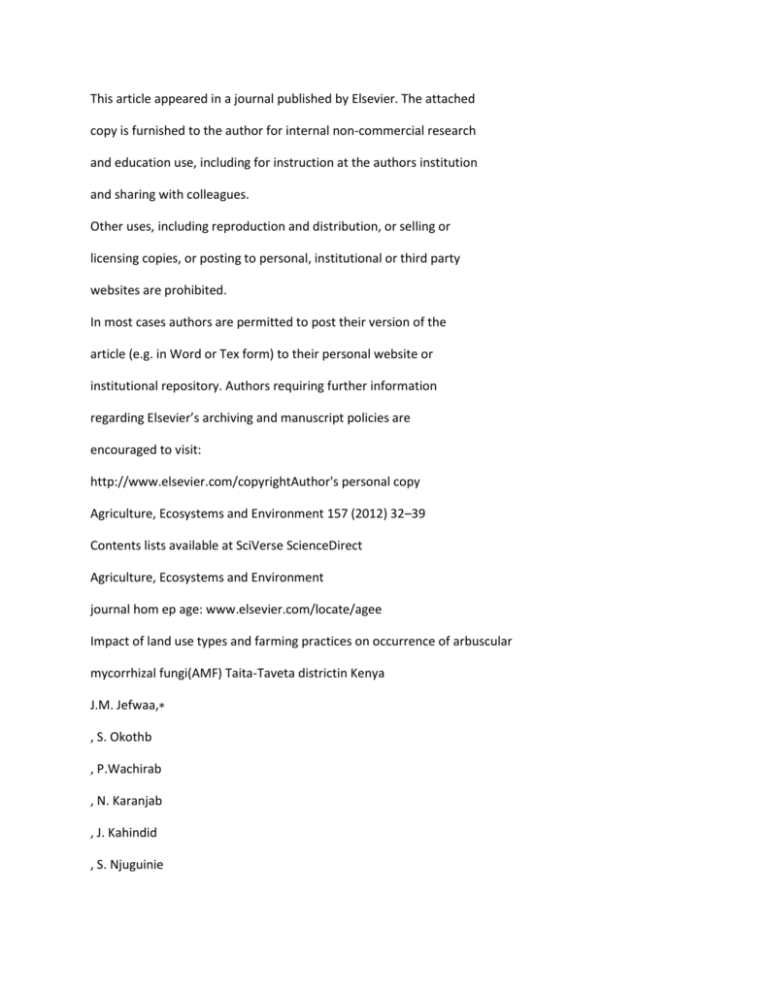
This article appeared in a journal published by Elsevier. The attached
copy is furnished to the author for internal non-commercial research
and education use, including for instruction at the authors institution
and sharing with colleagues.
Other uses, including reproduction and distribution, or selling or
licensing copies, or posting to personal, institutional or third party
websites are prohibited.
In most cases authors are permitted to post their version of the
article (e.g. in Word or Tex form) to their personal website or
institutional repository. Authors requiring further information
regarding Elsevier’s archiving and manuscript policies are
encouraged to visit:
http://www.elsevier.com/copyrightAuthor's personal copy
Agriculture, Ecosystems and Environment 157 (2012) 32–39
Contents lists available at SciVerse ScienceDirect
Agriculture, Ecosystems and Environment
journal hom ep age: www.elsevier.com/locate/agee
Impact of land use types and farming practices on occurrence of arbuscular
mycorrhizal fungi(AMF) Taita-Taveta districtin Kenya
J.M. Jefwaa,∗
, S. Okothb
, P.Wachirab
, N. Karanjab
, J. Kahindid
, S. Njuguinie
, S. Ichamia
, J. Mung’atuc
,
P. Okotha
, J. Huisinga
a
CIAT-Tropical Biology and Fertility Institute (TSBF), P.O. Box 823-00621, Nairobi, Kenya
b
Nairobi University, College of Biological and Physical Sciences, P.O. Box 29053, Nairobi, Kenya
c
Jomo Kenyatta University of Agriculture and Technology, P.O. Box 62000-00200, Nairobi, Kenya
d
United States International University, P.O. Box 14634-00800, Nairobi, Kenya
e
National Museums of Kenya, Botany Department, P.O. Box 45166, Nairobi, Kenya
articleinfo
Article history:
Received 21 June 2011
Received in revised form 5 April 2012
Accepted 7 April 2012
Available online 24 May 2012
Keywords:
Land use
Farming practices
Mycorrhize fungi
abstract
A study was undertaken along land use gradients in Taita-Taveta district, southeast Kenya to evaluate
the occurrence of arbuscular mycorrhizal fungi (AMF) in seven land use types (LUT). The gradient
was from indigenous forest (IF) to croplands with coffee (CO), maize (MA), horticulture (HT), napier
(NA) and planted forest (PF). A total of 12 AMF morphotypes comprising of 4 Glomus, 1
Claroideoglomus, 5Acaulosporaceae, 1 Racocetra sp. and 1Gigaspora were isolated from the study site.
Occurrnace of
Acaulospora denticulata, Glomus ambisporum and Claroideoglomus etunicatum was significantly
(p<0.05)
affected by LUT; A. denticulata, Acaulospora laevis, G. ambisporum, Glomus sp. 1, Glomus sp. 2 and
Gigaspora margarita were common in all LUT; C. etunicatum andGlomus sp. 3 were restricted and
Acaulospora
scrobiculata and two additional undescribed morpotypes were found only in trap cultures. Mean spore
abundancewassignificantly(p=0.007)differentincroppedsystemswithCO(35),HT(36.6)andMA(41.7)
recording lower mean spore abundance compared to non-cropped systems with PF (130), NA (91.3), FA
(89.7) and NA (84.3). AMF species showed preference for either cropped or non-cropping systems and
species diversity and richness were maintained despite dramatic changes in LUT.
© 2012 Elsevier B.V. All rights reserved.
1. Introduction
The Taita Hills is situated in the Northmost part of the eastern
arcmountainsandcoastalforesthotspots (Burgessetal.,2007).Itis
withinthe internationalbiodiversityhotspotwithhighendemicity
and severe degree ofthreat ranking first among the 25 hotspots in
thenumber of endemicplants (Myers et al., 2000).It occupies over
1000km2
with over 400 plant species of which 13 are endemic
recorded and nine endemic animals (Beentje, 1988). It is considered the most vulnerable hotspotlikely
to suffer plant and animal
extinctiondue to loss ofhabitat(Myers et al., 2000). The landscape
is dominated by intensive agriculture at high altitude and extensive agriculture andgrazing atthe foothills
andplains surrounding
∗
Corresponding author. Tel.: +254 20 7224776;fax: +254 20 7224763;
mobile: +254 0717720108.
E-mail addresses: jjefwa@cgiar.org (J.M. Jefwa), dorisokoth@yahoo.com
(S. Okoth), wachirapm@yahoo.com (P.Wachira), nancykaranja@cgiar.org
(N. Karanja), jkahindi@usiu.ac.ke (J. Kahindi), suskabs@yahoo.com (S. Njuguini),
s.ichami@cgiar.org (S. Ichami), kmungatu@yahoo.com (J. Mung’atu),
p.okoth@cgiar.org (P. Okoth), j.huising@cgiar.org (J. Huising).
the hills. Subsistence farming and high population pressure, with
increase from 90,146 in 1962 to 300,000 persons in 2001, has
caused dynamic changes in the land use patterns tending to seriousdegradation(Burgess et al.,
2007;Maeda et al., 2010). Landuse
practices largelyaffect chemical,physical andbiologicalproperties
of soils. Biological properties of soils are the least assessed of the
three yet nutrient cycling processes are largely mediated by soil
organisms. The mycorrhizal fungi are among organisms that play
a key role in ecosystemfunctioning (Klironomos et al., 2000). They
formmutuallybeneficial associationswithplants andarekeystone
to soil processes (Van der Heijden et al., 1998a,b; Power and Mills,
1995). The arbuscular mycorrhizae fungi(AMF)in the new plylum
Glomeromycota(Schußleretal.,2001),isthemostwidespreadofthe
mycorrhizal associations. They associate with80%of plant species,
hence may greatly influence direction of ecosystem change. Arbsucular mycorrhizae link soil and the
plant environment hence all
factors that affect soil and plants have impacts onAMF occurrence
and functions.
Mycorrhizal symbiosis is important for maintaining and promoting the productivity of croplands,
rangelands and forests, and
may be criticalto the maintenance of biodiversity (Sanginga et al.,
1992; Allen et al., 1995). Land use intensity is increasing with
0167-8809/$ – see front matter © 2012 Elsevier B.V. All rights reserved.
http://dx.doi.org/10.1016/j.agee.2012.04.009Author's personal copy
J.M. Jefwa et al. / Agriculture, Ecosystems and Environment 157 (2012) 32–39 33
Table 1
Mean soil nutrients and pH across seven land use type.
Land use types Soil nutrients
pH (H2
O) Carbon (%) Acidity (%) Nitrogen (%) Phosphorus (ppm) Potassium (Cmolkg−1
) Zinc (Cmolkg−1
)
Coffee 4.79 1.78 0.39 0.20 14.4 0.25 3.77
Fallow 4.27 1.93 0.83 0.27 13.1 0.46 1.95
Horticulture 4.78 1.57 0.33 0.20 15.2 0.31 3.42
Indigenous forest 3.72 2.55 1.19 0.42 27.8 0.23 3.40
Maize 4.59 1.68 0.31 0.20 12.5 0.38 4.50
Napier 4.93 1.89 0.34 0.28 15.2 0.76 6.16
Planted forest 3.06 2.88 2.38 0.38 5.3 0.10 0.74
expanding human populations leading to negative effects of mycorrhizalfungi in soils that have been
damaged (Allen, 1988). Crops
such as maize, beans, coffee bananas, cassava and other root and
tuber cropswhichbenefitfromAMF associationsdominateAfrica’s
landscape (Sieverding,1991;Jefwa et al.,2010).Itishowever likely
thatthebenefitsfrommycorrhizalassociationarehighlyinfluenced
by land use practices. Soil degradation has not only affected soil
chemical and physical properties but biological properties as well.
Theoccurrenceof soilbiotasuchasAMF species richnessandspore
abundance are low in some farming systems of Central parts of
Kenya (Jefwa et al., 2009). The Taita hills is equally densely populated and forestland encroached and
converted to settlement and
farmlands (Newark, 1998). A study was undertaken to determine
the impact of land use types on the occurrence of AMF.
2. Materials and methods
2.1. Site description
The 200km2
study site is located in southeast Kenya, 25km
westofVoitowninTaita-Tavetadistrict,CoastalprovinceofKenya,
sharing a border with Tanzania. The site is within the Taita hills
whichformspart ofthe easternarcmountainsdatedover 100million years. Itlies between longitudes 38◦
15
and 38◦
30
East ofthe
Greenwich and latitudes 2
◦
15
and 2
◦
30
South ofthe Equator. The
average altitude is 1500m with the highest peak at 2300m a.s.l.
compared to the vast surrounding semi-arid peneplain which is
500m a.s.l. Rainfall range from 440mm at the plains to 1900mm.
Due to the temperature and humid climate of the hills, the Taita
Hills are more densely populated than the rest ofthe district with
a population density of about 78inhabitantsperkm2
compared
to the rest of the district with an average of 14inhabitantskm−2
(Burgess et al., 2007). Populationofthe districtin1962 was 90,000
persons current population is 300,000 density. It is dominated
by intensive agriculture (extensive agriculture and grazing at the
foothills and plains surrounding the hills with the highly fragmented forest: Ngangao (120ha), Mbololo
(220ha) and Chawia
(86ha) forests (Rogers et al., 2008). Subsistence farming and high
population pressure has caused dynamic changes in the land use
patterns, leading to serious land degradation in the hills (Burgess
et al., 2007).
Land use types in the study area were classified as cultivation,
cultivation and grazing, grazing and forest(Muya et al., 2009). For
the purposes of this study land use kinds were designated into
seven broad categories that included: maize, horticulture, fallow,
napier, planted forests, and indigenous forests. In this paper fallow land refers to land that was once
farmland but at the time of
sampling, had been abandoned or left under no cultivation. The
plantedforestisdominatedbyEucalyptus saligna SmandCupressus
lusitanica Mill., Pinus patula Schiede ex Schttdl. & Cham and Pinus
radiata D. Don species. The soils are mainly Humic Nitisols (FAOUNESCO,1987)that arederivedfrombasic
volcanic rocks (Jaetzold
andSchmidt,1983). They aredeep,welldrained,weatheredwitha
friableclaytextureandmoderatetohighinherentfertility.Thearea
receivesatotalmeanannual rainfallofbetween1200and1500mm
in two rainy seasons, ‘long rains’ (March to June) and ‘short rains’
(mid October to December). Mean monthly temperature ranges
between14◦
Cand19.5◦
C.Bothrainfallpatternanduneventopography result in variable rainfall distribution. In addition to this,
geologicalpatterns leadtohighsoilsvariability.Thecombinationof
thebiophysicalfactorshelps tocreatefouragro-ecological zones in
the area thatinclude: uplands, midlands, valley bottoms and lowlands. The soils are highly acidic and low
in nutrients and carbon
(Table 1).
2.2. Sampling procedure
Soils were sampledfrom43points inthe sevendesignatedland
use categories (5 coffee (CO), 7 maize (MA), 5 horticulture (HT), 13
fallow(FA), 4 napier (NA), 3 planted forest(PF), 6 indigenous forest
(IF) atdepths of 0–20 and20–40cmusing a soil auger andsamples
pooled together to a composite sample. The samples were collected attwo radii of concentric circles
surrounding a centre point
monolith. The circles were located 3 and 8m away from the centre monolith atfour cores per radius
according to sampling layout
(Moreira et al., 2008).
A total of 12 samples were taken from each point and the sampled soils were pooled together to make a
composite sample of
1kg. Samples were collected in the dry season, a period when
sporulationincrease(GuadarramaandAlvarez-Sanchez,1999).The
samples were split for use in spore extraction, soil trap cultures
and nutrient analysis. Only one season was sampled and some
speciesmaynotbeinsporeformatthetimeof sampling.After
sampling,thesoiltrapculturewasestablishedwithSorghumbicolor (L.)
Moenche, Moenche Mucuna puriens (L.) DC, Senna spectabilis (DC.)
Irwin&Barneby(syn.Cassiaspectabilis)andGliricidiasepium(Jacq.)
in different 1l pots to allow for sporulation and to capture higher
species diversity. A sample of 250g soil from the field was mixed
withsterile sandysoil at a ratioof2:1.Atleast50seedsof Sorghum
and five each of the remaining plants were sown into the 1l pot.
The cultures were maintained under greenhouse conditions for a
period of 5 months.
2.3. Spore processing and identification
Sporeswere extractedfrom250g soil sample atportionsof50g
per extraction by water and sucrose centrifugation method modified by using a 270 and 45mmesh sieves and 60 (w/v) of sucrose
(Jenkins, 1964). The spores were distinguished into morphotypes
under reflectedlightonstereomicroscopewithcolorofspore,spore
size, attachments on spore and surface appearance of spore used
as the diagnostic features and the number of spores counted for
each morphotype. The Edinburgh Botanic Gardens color chart for
fungi was used to determine spore color.Voucher specimens were
prepared for each AMF morphotype and further described under
a compound microscope with spore germination characteristics,Author's personal copy
34 J.M. Jefwa et al. / Agriculture, Ecosystems and Environment 157 (2012) 32–39
Table 2
Rankoftotal sporeabundancein50g
−1
airdriedsoilandproportionsofAMFspecies
from the study site.
AMF species Rank Total abundance Proportion
Glomus ambisporum 1 825 28.1
Acaulospora laevis 2 670 21.8
Acaulospora sp. 1 3 417 13.6
Acaulospora denticulata 4 376 12.2
Glomus sp. 1 5 221 7.2
Racocetra verrucosa 6 172 5.6
Gigaspora margarita 7 140 4.6
Glomus sp. 2 8 128 4.2
Acaulospora sp. 2 9 44 1.4
Acaulospora sp. 3 10 31 1.0
Claroideoglomus etunicatum 11 6 0.2
Glomus sp. 3 12 5 0.2
spore wall characteristics,type spore wall, size and number oflayers and reaction to Melzer’s reagent
used as diagnostic features.
The spores were matched with species described by International
Culture Collection ofVA Mycorrhizal Fungi(INVAM)WestVirginia
University Morgantown,WV, USAWebsite and Schenck and Perez
(1990). Attempts to establish spore cultures were made for final
determination and confirmation ofthe species.
3. Statistical analysis
AnalysisofvarianceusingGenstat14thEditionwasusedtocompute the significant effect of land use on AMF
spore abundance.
Bonferronitest, apost-ANOVAtestwasusedfor comparingpairsof
LUT. Extrapolating techniques using non-linear regression model
such as the species accumulation curve was used to estimate the
number of species that would be found in a complete survey, but
may not have been encountered from the reported survey (Karl
et al., 2003). The species accumulation curves, was used to estimate species richness and rank
abundance of species across sites
and LUTs (Colwell et al., 2004). Genetic diversity indices (hereafter meaning species richness, abundance
and Shannon Index)
were computed using the R statistical package called Biodiversity
R (Kindt and Coe, 2005).
Species richness, species diversity (using Shannon), and the
proportion of the land use type with most abundant AMF were
computed by Renyi diversity profiles, H
species diversity (using Shannon Index), and the proportion
of the land use type with most abundant AMF were computed
by Rènyi diversity profiles, extrapolating techniques (Tóthmérész,
(H-alpha). Species richness,
1993;Pielou,1975;Rènyi,1961).Rényidiversityprofilesarecurves
that also provide information on richness and evenness, as rank
abundance curves do. Rényi diversity profiles have the advantage
over rank-abundance curves that ordering from lowest to highest
diversity is easier. For this reason, aRényidiversityprofile is one of
several diversity ordering techniques (Tóthmérész, 1993).
Population estimates such as Jacknife were used to extrapolate the expected number of species in the
survey area. Similarity
index was used to derive dendograms that establish similarities
between land use types in terms of species composition (Legendre
and Gallagher, 2001).
4. Results
4.1. AMF species composition
Atotalof12speciesweredistinguishedonthebasisofmorphological features directly from the field (Table
2). Three additional
species were observed from trap cultures. Six morphotypes were
identified positively at species level based on descriptions in literature to Acaulospora laevis Gerd. &
Trappe, Glomus ambisporum
Table 3
Mean spore abundance in 50g
−1
air dried soil of AMF species community across
land use types.
AMF species CO FA HT IF MA NA PF
A. laevis 9.2 19.9 7.4 20.8 13.1 11.0 22.3
A. denticulata 0.4 7.9 1.0 11.8 0.4 12.3 61.3
Ac. sp. 1 0.2 1.2 0.6 1.0 0.4 0 0.7
G.ambisporum 17.8 26.4 8.2 22.7 5.3 26.5 37.7
Glomus sp. 1 1.4 10.9 3.2 1.5 3.1 6.3 0.3
Glomus sp. 2 1.0 4.9 3.6 1.8 3.1 1.5 0.7
C. etunicatum 0 0 0 0 0.9 0 0
R. verrucosa 0 2.9 1.2 12.7 3.9 1.5 6.3
G. margarita 2.6 4.9 4.8 4.2 1.7 0.3 0.7
Ac. sp. 2 2.4 10.5 5.0 6.0 5.7 31.8 0
Ac. sp. 3 0.4 0.3 0.6 1.8 3.3 0.3 0
Glomus sp. 3 0 0 0 0 0.7 0 0
Note:CO=coffee;FA=fallow;HT=horticulture;IF=indigenous forests;MA=maize;
NA=napier; PF=planted forests;Ac. sp. 1=Acaulospora sp. 1;Ac. sp. 2=Acaulospora
sp. 2; Ac. sp. 3=Acaulospora sp. 3.
Smith & Schenck and Claroideoglomus etunicatum (Becker & Gerd.)
Walker & Schussler and Acaulospora denticulata Sieverding & Toro.
Racocetra verrucosa (Koske&Walker)Oehl, Souza&Sieverdingand
Gigaspora margarita Becker & Hall. The remaining morphotypes
were classified as distinct morphotypes but could not be matched
withknowndescribedspecies.Fewspeciesseemedtodominatethe
landscape with the four most dominant species containing 75.7%
of all spores encountered (Table 2). The spores of Glomus spp. and
Acaulosporaspp.accountedfor the39.9%and50%, respectively.The
proportionsof sporesofR.verrucosaandG.margaritaweretheleast
accounting for only 16.1%. The three additional AMF morphotypes
from trap cultures were Acaulospora sccrobiculata Trappe which
occurredinallLUTsexceptHTandNAandtwounidentifiedspecies.
The spores of G. ambisporum were the most dominant atthe study
site. The upper and lower confidence limits of Acaulospora sp. 1, A.
denticulataandR.verrucosaweretoowidesignifyinguncertaintyof
thetruemeanfor thesespecies.This suggests thatthethreespecies
arehighlydispersedindistributionatthestudyareaof6km2
across
seven LUTs.
4.2. AMF spore abundance
Exploratory data analysis using boxplot showed variable range
ofdistributionof spores withinLUTs (Fig. 1). Spore abundance was
positivelyskewedparticularlyinLUTswithplantedforests (PF)and
fallow (FA), signifying non-normal distribution. The range of spore
abundance was wide inLUTs withPF,IF and NA. Landuse typehad
significant(p=0.006)effectonAMFsporeabundance(Fig.2).There
were marked differences in mean spore abundance between land
use types PF, NA, IF and FAhad the highest mean spore abundance
which was more than twice the spore abundance in LUTs under
cultivation (MA, HT and CO) had the least spore abundance.
Using a generalized linear model for presence and absence of
species, the occurrence of AMF was confirmed to vary in each
LUT with four species significantly affected (Table 3). The spore
abundance of A. denticulata (p=0.009), G. ambisporum (0.005), C.
etunicatum (p=0.012) and Acaulospora sp. 1 (p=0.07) were variable across LUTs. At least six species (A.
laevis, A. denticulata, G.
ambisporum, Glomus sp. 1, Glomus sp. 2 and G. margarita) occurred
in all LUTs, two species (C. etunicatum and Glomus sp. 3) occurred
only in LUT with maize and Acaulospora sp. 1 and Acaulospora sp.
3 were low in all LUT A. denticulata was highest in PF, NA and IF
in descending order and least in CO, HT and MA. G. ambisporum
was alsocommoninall LUTbuthighestinPF, FA,NA,IF,CO,HTand
MAindescendingorder.R.verrucosawashighestinindigenousand
plantedforest.A.laeviswas leastinHTandCOandG.margaritawas
leastin NA and PF.Author's personal copy
J.M. Jefwa et al. / Agriculture, Ecosystems and Environment 157 (2012) 32–39 35
Fig. 1. Range of AMF spore abundance within a land use type.
4.3. AMF species richness and diversity
Atotalof12specieswererecoveredfromfieldsoils inthesurvey
andfurther extrapolationwithjacknife alsopredictedspecies richness of 13.95 (Table 4). The species
accumulation curve reached a
plateau with slightly above 13 species at approximately 26 sampling points (Fig. 3). The number of LUT
sampled was unequal,
hence, species accumulation curves generated for individual LUT
differedatthepointof climax(Fig.4).Acomparisonof species richness for individual LUT showed no
significant different in species
richness (p=0.9), however, species accumulation curve reached a
plateauatvariablepointsandsomenever reached.Jacknifeextrapolation for individual LUTs predicted more
species in MA and PF
than was recoveredfromthefield. The species accumulationcurve
for individual LUT showed all LUTs except MA and PF to reach
a plateau with the number of sampling points used during the
survey.
Rènyi’s diversity profile was used to provide information on
speciesdiversity (Fig.5).Theprofiles indicateHTwasmorediverse
than MA, IF, FA, NA, PF and CO in descending order. The IF and MA
as well as CO and PF could not be unequivocally ordered, as the
profiles cross each other at different values of the scale parameter. At the ˛=0 scale, MA runs above IF
while CO runs above
PF. At the scale ˛=1 (Shannon Index), species diversity in LUT is
rankedHT>MA>FA>IF>NA>CO>PF.Rankingatscale˛=2(Simpson Index) is similar except for PF and coffee
which cross at this
point.ShannonIndexderivedfromsurveyforallLUTs showedrichness to be less than the Jacknife estimate
values and the diversity
of MA to precede HT (Table 4).
The land use types were grouped according to similarities
(Fig. 6). Similarity in AMF abundance was significant (p<0.01), by
mantel=0.73). Three groups of LUTs were distinguished: group
I consisting of only FA, group II consisting of NA but diverging somewhat from IF and PF which seem to
be very similar,
Fig. 2. Mean spore abundance of seven land use types.Author's personal copy
36 J.M. Jefwa et al. / Agriculture, Ecosystems and Environment 157 (2012) 32–39
Table 4
AMF species richness and diversity in 50g
−1
air dried soil.
Land use type (LUT) No. of sampling points Total richness Jacknife estimate Shannon diversity Jacknife
estimate
Coffee (CO) 5 9 9.8 1.43 1.45
Fallow (FA) 13 10 10 1.92 2.00
Horticulture (HT) 5 10 10.8 2.01 2.12
Indigenous forest(IF) 6 10 10.8 1.89 2.03
Maize (MA) 7 12 14.6 2.08 2.26
Napier (NA) 4 9 10.5 1.60 1.77
Planted forest(PF) 3 8 10 1.26 1.28
Total for all LUT 43
0 10 20 30 40
12 10 8 6 4 2
sites
species richness
Fig. 3. Species accumulation curve for AMF species in the field.
Group III consisting of HT and MA linking with CO at higher
level.
5. Discussion
5.1. AMF species composition
The number of species recovered from this site is within the
range of records in parts of Kenya, Cameroon and Malawi (Jefwa
et al., 2006, 2009; Mathimaran et al., 2007; Shepherd et al., 1996;
Masonetal.,1992).Thisiscomparativelylessthanspeciesrecorded
in Brazilian Amazon, Nicaragua, Costa Rica, tropical China and
Thailand (Stürmer and Siqueira, 2011; Songachan and Kayang,
2011; Cheroenpakdee et al., 2010; Zhao et al., 2003; Picone, 2003).
ThemajorityofspeciesGlomusspp.andAcaulosporaspp.werecommon in all LUT at variable proportions.
This may be attributed to
sporogenous characters of species whereby, it has been found that
Acaulospora and Glomus produce more spores than Scutellospora
2 4 6 8 10 12
12 10 8 6 4 2 0
sites
species richness
o
Coffee
a
H
Horti.
o
Indi. forest
Napier
o
Planted forest
Coffee
Fallow
Horti.
Indi. forest
Maize
Napier
Planted forest
F
PF
M
IF
C
H
N
Fig. 4. Species accumulation curve with respectto individual land use type.Author's personal copy
J.M. Jefwa et al. / Agriculture, Ecosystems and Environment 157 (2012) 32–39 37
0 0.25 0.5 1 2 4 8 Inf
2.0 1.5 1.0 0.5 0.0
alpha
H-alpha
Coffee
Coffee
Fallow
Fallow
Horti.
Horti.
Indi. forest
Indi. forest
Maize
Maize
Napier
Napier
anted forest
Planted fore
Coffee
Fallow
Horti.
Indi. forest
Maize
Napier
Planted forest
Fig. 5. Renyì diversity profile for all land use types.
and Gigaspora in the same environment (Bever et al., 1996). The
speciesA.laevis,A.denticulata,Ascrobiculata,G.ambisporum,C.
etunicatum,R.verrucosaandG.margaritahaveallbeenwidelyreported
in parts of Africa and other parts of the world (Porter et al., 1987;
Schreiner et al., 2009; Sieverding and Toro, 1987; Velazquez et al.,
2008; Jefwa et al., 2009; Mathimaran et al., 2007; Shepherd et al.,
1996).
5.2. AMF spore abundance
There was clear evidence of response of spore abundance and
not species richness and diversity following changes in land use.
General observations showed LUT under cultivation (CO, MA and
HT) to have lower spore abundance than non-cultivated (PF and
IF) and less frequently cultivated (NA and FA) LUTs. Disturbance
through cultivation of croplands may have caused the decline
in AMF abundance in this site. Soil disturbance by agricultural
activities has been shown to reduce the density of AMF spores
(Boddington and Dodd, 2000; Jasper et al., 1989; Boerner et al.,
1996; Gould et al., 1996; Wiseman and Wells, 2005). The practice
inthe regionformost croplands is characterizedby the application
of inorganic fertilizer and in some of the crops (CO and HT) pesticides application. Fertilization has also
been reported to decrease
AMF total spore abundance and variation in species richness and
diversity varying in their response (Bhadalung et al., 2005). This
may also explain the differences in spore numbers for individual
species in the LUTs. Both Acaulospora spp. and Glomus spp. were
more abundant in the landscape with some species prevalent in
specific LUT.A. laevis,A. deniculata,G. ambisporum andG. margarita
plus twoundescribedGlomus spp.were commoninall LUTs.A. laevis and G. ambisporum were the most
abundant species in all LUT.
The spore abundance of A. laevis was least in HT, CO, NA and MA
while G. ambisporum was least in MA and HT. With the exception of NA, the spore abundance of A.
laevis and G. ambisporum
was mostlikely affected by management practices. A. laevis in our
study occurred in soils of pH range of 3.06–4.93, concurring with
earlier studies which showed A. laevis to occur in soils of low pH
(Porter et al., 1987; Dickman et al., 1984). This may explain the
low spore abundance of A. laevis in LUTs with MA, HT, CO and NA
which had slightly higher pH levels. G. ambisporum was reported
Coffee
Horti.
Maize
Indi. forest
Planted forest
Napier
Fallow
0.60 0.55 0.50 0.45 0.40 0.35 0.30
Dendrogram of agnes(x = distmatrix, method = "average")
A gg lomerative Coefficient = 0.34
distmatrix
Height
Fig. 6. Dendogram representing land use types sharing similarities in AMF spore abundance.Author's
personal copy
38 J.M. Jefwa et al. / Agriculture, Ecosystems and Environment 157 (2012) 32–39
by Rokin et al. (2006) and Renuka et al. (2012) to occur in wide
range of conditions, a situation confirmed in this study. However,
spore abundance was lower in cropping systems with MA and HT.
Although A. denticulata was common in all LUTs, it was least in
cropping systems with CO, HT and MA and highestin planted forest system. This species was reported in
tropical forest, grassland
and communal lands which have limited interference byman (Zao
et al., 2003; Bever et al., 1996; Uhlmann et al., 2004). Similarly, Gi
margarita was common in all LUTs although in small numbers but
showed preference for croplands. This species has been reported
widely in natural and cropping systems in parts of Kenya and
Malawi (Jefwa et al., 2004, 2006; Mathimaran et al., 2007; Vasha
and Rodrigues, 2001; Khade and Rodrigues, 2008; Pagano et al.,
2010). The species R. verrucosa in our study was highest in noncropped systems with less anthropogenic
interference (NA, IF and
PF). This is supportedby studies inVenezuela andIndonesia which
indicated absence of genera Gigaspora and Scutellospora upon soil
disturbance imposed through practices such as agriculture with
AMF communities in disturbed soils dominated by Glomus and
Acaulospora (Selvam and Mahadevan, 2002; Cuenca et al., 1998;
Boddington and Dodd, 2000).
Inourstudy,A. scrobiculatawasfoundonlyintrapcultureswhile
C. etunicatum was rare and restricted to only LUTs with MA. Previous studies observed high spore
density of C. etunicatum at the
rhizosphere of maize and A. scrobiculata absent in disturbed sites
and studies in central and western Kenya and Cameroon showed
A. scrobiculata and C. etunicatum as the most widespread (Prasetyo
et al., 2010; Jefwa et al., 2006, 2009; Mason et al., 1992; Wilson
et al., 1992; Shepherd et al., 1996).
5.3. Species richness and diversity
The value twelve species isolated directly from field soils are
close to the Jacknife extrapolated predicted value of 13.95. The
species accumulation curve indicated approximately 26 sampling
points as adequate to recover atleast 13 species, implying 43 sampling points as over sampling
atlandscape level. Atindividual LUT
level, it was noted that some LUT such as MA and PF may require
extensivesamplingtorecover representativeAMFspecies for these
LUTs. Seven and three points were sampled for PF and MA respectively. Fewer points than MA were
sampled for NA (4), HT (5), IF
(6) and CO (5) but these points almost reached a plateau, indicatingsufficientpoints sampledfor
theseLUTs.Theneedforextensive
sampling in MA and may emanate from heterogeneity in management practices used by farmers inthe
applicationof differentfarm
inputs at variable rates. The planted forest was under sampled yet
it is a heterogeneous LUT dominated by E. saligna Sm. and C. lusitanica Mill., P. patula Schiede ex
Schttdl. & Cham. and P. radiata D.
Don. species.Thisconforms toCochran(1977)whosuggestedmore
sampling for highly heterogeneous samples.
Thedifferences inspecies richnessanddiversitywithchanges in
LUTwerelessevident.Violiet al.(2008)notedcontrastingpatterns
in sporulation among AMF families across different disturbance
typesandmaintenanceofspeciesrichnessandcompositiondespite
thedramaticchangesinhostcommunities.Theslightlyhighspecies
diversity in MA cannot be explained by the different attributes
of the different LUTs, hence indicating the role of other factors.
Edaphic factors, seasonality, host dependence and age were identified as factors affecting spore
sensitivity, species richness and
diversity (Khade and Rodrigues, 2008; Guadarrama and AlvarezSanchez, 1999). The studies by Galvez et
al.(2001) and Jansa et al.
(2002) showedcommunitystructureofAMF andsporenumbers to
be negatively affected by tillage treatments and high-input management. This study did not explore the
effects ofthese factors on
AMF.
6. Conclusion
AMF spore abundance grouped LUTs which shared similarity in
intensity. Using similarity index and dendograms,the distribution
of spores across LUT clearly distinguished land use under cultivation and non-cultivated. The LUTs with
NA, IF and PF were in the
same group and CO, MA and HT formed a different group, both
indicating similarities management practices for LUTs in the same
group. The LUTs with fallow was separate from the two groups.
Similar trends were noted in boxplots with land that was not cultivated showing higher variation than
cultivated land, implying
heterogeneity inlessmanagedlandandhomogeneity incultivated
land.
The study has shown LUTs with crops to reduce spore abundance than species richness and diversity.
Spores are propagation
propagules and survive in the soils longer particularly in adverse
climatic conditions. It is promising to note that species diversity
can still be sustained under cropping practices, however the fewer
sporesintheseLUTpointsouttoalikelihoodofloosingspecieswith
time.
Acknowledgements
We would like to thank GEF and UNEP for giving financial support, TSBF-CIAT for coordinating and
planning of all the activities
undertaken in this study, University of Nairobi for facilitating the
implementation of the activities, The National Museum of Kenya
for providing facilities, our respective institutions for allowing us
to undertake this research. We are particularly grateful to Peter
Wachira of BGBD Kenya and Victor Otieno, National Museum of
Kenya for facilitating field sampling and laboratory logistics.
References
Allen, E.B., Allen, M.F., Helm, D.J., Trappe, J.M., Molina, R., Rincon, E., 1995. Patterns
and regulation of mycorrhizal plant and fungal diversity. Plant Soil 170, 47–62.
Allen,M.F.,1988.Re-establishmentofVAmycorrhizaefollowingseveredisturbance:
comparative patch dynamics of a shrub desert and subalpine volcano. Proc. R.
Soc. Edinb. 94B, 63–71.
Beentje, H.J., 1988. Atlas of rare trees of Kenya. Utafiti 3, 71–123.
Bever, J.D., Morton, J.B.,Antonovics, J., Schultz, P.A., 1996. Host-dependent sporulation and species
diversity of arbuscularmycorrhizalfungi in amown grassland.
J. Ecol. 84, 71–82.
Bhadalung, N., Suwanarit, A., Dell, B., Napamornbodi, O., Thamchaipenet, A.,
Rungchuang, J., 2005. Effects of long-term NP-fertilization on abundance and
diversity of arbuscular mycorrhizal fungi under maize cropping system. Plant
Soil 270, 371–382.
Boddington, C.L., Dodd, J.C., 2000. The effect of agricultural practices on the development of indigenous
arbuscular mycorrhizal fungi. I. Field studies in an
Indonesian ultisol. Plant Soil 216, 137–144.
Boerner,R.E., DeMars,B.G., Leicht, P.N., 1996. Spatial patterns ofmycorrhizal infectiveness of soils along
a successional chronosequencemycorrhizae.Mycorrhiza
6, 79–90.
Burgess, N.D., Butynski, T.M., Cordeino, N.J., Doggart, N.H., Fjeldsa, J., Howell, K.M.,
Kilhama, F.B., Loader, S.P., Lovett, J.C., Mbilinyi, B., Menegon, M., Moyer, D.C.,
Nashanda,E.,Perkin,A.,Rovero,F.,Stanley,W.T.,Stuart,S.N.,2007.Thebiological
importance ofthe eastern arc mountains of Tanzania and Kenya. Biol. Conserv.
134, 209–231.
Cheroenpakdee, S., Phosri, C., Dell, B., Lumyong, S., 2010. The mycorhizal status
of indigenous arbuscular mycorrhizal fungi of physic nut (Jatropha curacas) in
Thailand. Mycosphere, 167–181.
Cochran,W.G.,1977.SamplingTechniques,Thirded.JohnWileyandSon,NewYork.
Colwell,R.K.,Mao, C.X., Chang,J., 2004.Interpolating, extrapolating, and comparing
incidence-based species accumulation curves. Ecology 85 (10), 2717–2727.
Cuenca, G., de Andrade, Z., Escalante, G., 1998. Diversity of glomalean spores from
naturaldisturbedandrevegetatedcommunitiesgrowingonnutrient-poor tropical soils. Soil Biol. Biochem.
30, 711–719.
Dickman, L.A., Liberta, A.E., Anderson, R.C., 1984. Ecological interaction of little bluestem and vesiculararbiscular mycorrhizal fungi. Can. J. Bot. 62 (11),
2272–2277.
FAO-UNESCO,1987.In:Creutzberg,D.(Ed.),SoilMapoftheWorld.ISRIC,Wagenigen.
Galvez,L.,Douds,D.D.,Drinkwater,L.E.,Wagoner,P.,2001.Effectoftillageandfarming
systemuponVAMfunguspopulations andmycorrhizas andnutrientuptake
of maize. Plant Soil 228, 299–308.Author's personal copy
J.M. Jefwa et al. / Agriculture, Ecosystems and Environment 157 (2012) 32–39 39
Gould, A.B., Hendrix, J.W., Ferris, R.S., 1996. Relationship of mycorrhizal activity to
timefollowingreclamationof surfaceminelandinwesternKentucky.I.Propagules and spore population
densities. Can. J. Bot. 74, 247–261.
Guadarrama,P.,Alvarez-Sanchez,A.F.J.,1999.AbundanceofArbuscularmycorrhizal
sporesindifferentenvironmentinatropical rainforest,Verracruz,Mexico.Mycorrhiza 8, 267–270.
Jansa, J., Mozfar, A., Anken, T., Ruh, R., Sanders, I.R., Frossard, E., 2002. Diversity
and structure of AMF communities as affected by tillage in a temperate soil.
Mycorrhiza 12, 225–234.
Jaetzold, R.H., Schmidt, H., 1983. Farm Management Handbook of Kenya, vol. II/B.
Central Kenya. Ministry of Agriculture, Nairobi, Kenya.
Jasper, D.A.,Abbott, L.K.,Robson,A.D., 1989. Soil disturbance reduces the infectivity
of external hyphae of VA mycorrhizal fungi. New Phytol. 112, 93–99.
Jefwa, J., Vanlauwe, B., Coyne, D., van Asten, P., Gaidashova, S., Rurangwa, E.,
Mwashasha,M., Elsen,A., 2010.Benefits andpotentialuse of arbuscularmycorrhizal fungi(AMF). In:
Dubois, T., Hauser, S., Staver, C., Coyne, D.(Eds.), Proc. IC
on Banana and Plantain in Africa. Acta Hort., 479–486.
Jefwa,J.M., Mungatu,J., Okoth, P., Muya, E., Roimen, H., Njuguini, S., 2009. Influence
ofland use types on the occurrence of arbuscular mycorrhizalfungi in the high
altitude regions of Mt. Kenya. J. Trop. Subtrop. Agroecosyst. 11, 277–290.
Jefwa,J.M.,Sinclair,R.,Maghembe,A.J.,2006.Diversityofglomalemycorrhizalfungi
inmaize/sesbaniaintercropsandmaizemonocropsystems inSouthernMalawi.
Agrofor. Syst. 67, 107–114.
Jefwa,J.M.,Mwangi, L.M., Odee, D.,Mugambi, G., 2004. Preliminary studies onmycorrhizal symbiosis
inplant conservationforestry andfarming systems inKenya.
J. Trop. Microbiol. 3 (1), 48–62.
Jenkins, W.R., 1964. A rapid centrifugal-floatation technique for separating nematodes from soil. Plant
Dis. Rep. 48, 692.
Karl, I.U., Gray, J.S., Ellingsen, K.E., 2003. The species—accummulation curve and
estimation of species richness. J. Anim. Ecol. 75 (5), 879–888.
Khade, S.W., Rodrigues, B.F., 2008. Ecology of arbuscular mycorrhizal fungi
associatedwithCaricapapayaL.inagro-basedecosystemofGoa,India.J.Trop.Subtrop.
Agroecosyst. 8, 265–278.
Kindt,R.,Coe,R.,2005. Tree DiversityAnalysis.AManual andSoftware forCommon
Statistical Methods for Ecological and Biodiversity Studies. World Agroforestry
Centre (ICRAF), Nairobi.
Klironomos, J.N., McCune, J., Hart, M., Neville, J., 2000. The influence of arbuscular
mycorrhizaeonthe relationshipbetweenplantdiversity andproductivity.Ecol.
Lett. 3, 137–141.
Legendre,P.,Gallagher,E.D.,2001.Ecologicallymeaningfultransformations forordination of species data.
Oecologia 129, 271–280.
Maeda, E.E., Clark, P.P., Siljander, M., 2010. Modelling agricultural expansion
in Kenya’s eastern arc mountains biodiversity hotspot. Agric. Syst. 103 (9),
609–620.
Mason, P.A., Musoko, M.O., Last, F.T., 1992. Short term changes in vesicular arbuscularmycorrhizal
spore populations inTerminalia plantations inCameroon.In:
Read, D.J., Lewis, D.H., Fitter, A.H., Alexander, I.J. (Eds.), Mycorrhizas in Ecosystems. CAB
International,Wallingford, UK, pp. 261–267.
Mathimaran,Ruh,N.,Jama,R.,Verchont,B., Frossard, L.,2007.Impactof agricultural
managementonarbuscularmycorrhizalfungalcommunities inKenyanferrasol.
Agric. Ecosyst. Environ. 119, 22–32.
Moreira, F.S., Huising, J.E., Bignell, D.E., 2008. A Handbook of Tropical Soil Biology: Sampling and
Characterization of Below Ground Biodiversity. Earthscan,
London.
Muya,E.M.,Karanja,N.,Okoth,P.F.Z.,Roimen,H.,Mungatu,J.,Mutsotso,B.,Thuranira,
G., 2009. Comparative description of land use and characteristics of belowground biodiversity
benchmark sites in Kenya. J. Trop. Subtrop. Agroecosyst.
11 (2), 263–275.
Myers, N., Mittermeier, R.A., Mittermeier, C.G., Da Fonseca, C.A.B., Kent, J., 2000.
Biodiversity hotspots for conservation priorities. Nature 403, 853–858.
Newark, W.D., 1998. Forest area fragmentation, and loss in the eastern arc mountains:implications for
the conservationofbiologicaldiversity.J.E.Afr.Nat.Hist.
87, 1–8.
Pagano, M.C., Cabello, M.N., Scotti, M.R., 2010. Arbuscular mycorrhizal colonization
and growth of Eremanthus incanus Less. in a highland field. Plant Soil Environ.
56 (9), 412–418.
Picone, C., 2003. Managing mycorrhizae for a sustainable agriculture in the tropics.
In: Vandermeer, J. (Ed.), Advances in Agroecology in Tropical Agroecosystems.
CRC Press Inc., Boca Raton.
Pielou, E.C., 1975. Ecological Diversity.Wiley-Interscience, New York.
Porter, W.M., Robson, A.D., Abbott, L.K., 1987. Field survey of the distribution of
vesicular-arbuscular mycorrhizal fungi in relation to soil pH. J. Appl. Ecol. 24,
659–662.
Power, M.E., Mills, L.S., 1995. The keystone cops meetin Hilo. Tree 10, 182–184.
Prasetyo, B.,Krisnayanti, B.D., Utomo,W.H.,Anderson, C.W., 2010. Rehabilitation of
artisanalmininggoldlandinWestLombok,Indonesia.2.Arbuscularmycorrhizal
status oftailings and surrounding soils. J. Agric. Environ. Sci. 2 (2), 202–209.
Renuka, G., Rao, M.S., Ramesh, M., Kumar, P.V., Reddy, S.M., 2012. Distribution and
diversityofAMfungalflora inGodvarcbeltforests,AndhraPradesh,India.Asian
J. Exp. Biol. Sci. 3 (1), 228–235.
Rènyi, A., 1961. On measure of entropy and information. In: Neyman, J. (Ed.),
Proceedings of the 4th Berkeley Symposium on Mathematical Statistics and
Probability. Univ. California Press, Berkeley, pp. 547–561.
Rogers,P.C.,O’Connell,B.,Mwang’ombe,J.,Madoffe,S.,Hertel,G.,2008.Foresthealth
monitoring in the Ngangao forest, Taita Hills, Kenya: a five year assessment of
change. J. E. Afr. Nat. Hist. 97 (1), 3–17.
Rokin, N., Goltapeh, E.M., Alizadeh, A., 2006. Introducing one species of arbuscular
mycorrhizal fungi from Khuzestan sugarcane fields in Iran. Rostaniha 7, 2.
Sanginga, N., Mulongoy, K., Swift, M.J., 1992. Contribution of soil organisms to the
sustainabilityandproductivityofcroppingsystems inthetropics.Agric.Ecosyst.
Environ. 41, 135–152.
Schußler, A., Schwarzott, D., Walker, C., 2001. A new fungal phylum, Glomeromycota: phylogeny and
evolution. Mycol. Res. 105, 1413–1421.
Schenck,N.C.,Perez,Y.,1990.Manualfor the IdentificationofVAMycorrhizal Fungi.
Synergistic Publications, Gainesville.
Schreiner, R.P., Mihara, K.L., 2009. The diversity of arbuscular mycorrhizal fungi
amplified from grapevine roots (Vitis vinifera L.) in Oregon vineyards is seasonally stable and influenced
by soil and vine age. Mycologia 10 (5), 599–611.
Selvam, A., Mahadevan, A., 2002. Distribution of mycorrhizas in an abandoned fly
ashpondandminedsitesofNeyveliligniteCorporation,Tamil,India.BasicAppl.
Ecol. 3 (3), 277–284.
Shepherd,K.D.,Jefwa,J.,Wilson,J.,Ndufa,J.K.,Ingleby,K.,Mbuthu,K.W.,1996.Infection potential of farm
soils as mycorrhizal inocula for Leucaena Leucocephala.
Biol. Fertil. Soils 22, 16–21.
Sieverding, E., 1991. Vesicular-Arbuscular Mycorrhiza Management in Tropical
Agrosystems. Eschborn and Hartmut Bremer Verlag, Friedland.
Sieverding, E., Toro, S.T., 1987. Acaulospora denticulata sp. nov. and Acaulospora
rehmii sp. nov. (Endogonaceae) with ornamented spore walls. Angew. Botanik
61, 217–223.
Songachan, L.S., Kayang, H., 2011. Diversity of arbuscular mycorrhizal fungi in pine
forest of Meghalaya, North, EastIndia. Mycosphere, 497–505.
Stürmer, S.L., Siqueira, J.O., 2011. Species richness and spore abundance of arbuscular mycorrhizal fungi
across distinctland uses inWestern Brazilian Amazon.
Mycorrhiza 21, 255–267.
Tóthmérész, B., 1993. DIVORD 1.50. A program for diversity ordering. J. Veg. Sci. 6,
283–290.
Uhlmann, E., Görke, C., Peterson, A., Oberwinkler, F., 2004. Comparison of species
diversityof arbuscularmycorrhizalfungiinwinter-rainfall areasof SouthAfrica
and summer-rainfall areas of Namibia. J. Mycol. Prog. 3 (4), 267–274.
VanderHeijden,M.G.A.,Boller,T.,Wiemken,A.,Sanders,I.R.,1998a.Differentarbuscularmycorrhizalfungal
speciesarepotentialdeterminantsofplantcommunity
structure. Ecology 79, 2082–2091.
Van der Heijden, M.G.A., Kilronomos, J.N., Ursic, M., Moutoglis, P., Streitwolf-Engel,
R., Boller, T., Wiemken, A., Sanders, I.R., 1998b. Mycorrhizal fungal diversity
determines plant biodiversity, ecosystem variability and productivity. Nature
396, 69–72.
Vasha, J., Rodrigues, B.F., 2001. Occurrence and distribution of arbuscular mycorrhizal fungi in coastal
sand dune vegetation of Goa. Curr. Sci. 80 (7),
826–827.
Velazquez, M.S., Cabello, M., Irrazabal, G., Godeas, A., 2008. Acaulosporaceae from
El Palmar National Park, Entre Rios, Argentina. Mycotaxon 103, 171–187.
Violi,H.A.,Alejandro, F.,Barrientos-Priego.Wright, S.F.,Escamilla-Prado,E.,Morton,
J.B., Menge, J.A., Lovatt, C.J., 2008. Disturbance changes arbuscular mycorrhizal
fungalphenologyandsoilglomalinconcentrationsbutnotfungal spore
compositioninmontanerainforestsinVeracruzandChiapas,Mexico.For.Ecol.Manage.
254, 276–290.
Wilson,J.,Ingleby,K.,Mason,P.A.,Ibrahim,K.,Lawson,G.J.,1992.Long-termchanges
invesicular arbuscularmycorrhizal sporepopulations inTerminaliaplantations
inCoted’Ivoire.In:Read, D.J., Lewis, D.H., Fitter,A.H.,Alexander,I.J.(Eds.),Mycorrhizas in Ecosystems. CAB
International,Wallingford, UK, pp. 268–275.
Wiseman, P.E., Wells, C., 2005. Soil inoculum potential and arbuscular mycorrhizal
colonization of Acer rubrum in forested and developed landscapes.J.Aboricul. 3
(6), 296–301.
Zao, Z.W., Wang, G.H., Yang, L., 2003. Biodiversity of arbuscular mycorrhizal fungi
in tropical rainforest of Xishuangbanna, southwest China. Fungal Divers. 13,
233–242.


